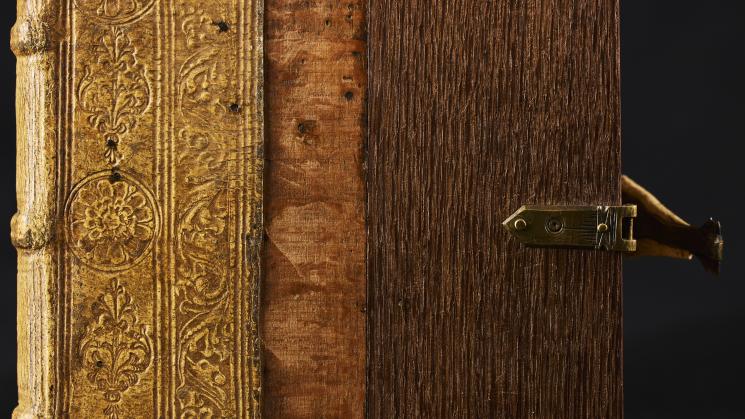Discovering the Elemental Book

You are sitting down in the reading room of the JCB, an open text resting on book cradles in front of you. The book is the 1504 edition of Margarita Philosophica, Gregor Reisch’s textbook on the trivium and the quadrivium. You are taking notes about this system of knowledge that was central not only in European universities but also in the first higher education institutions of the colonial Americas.
When you close the book, your attention wanders from the contents to the physical appearance of the volume. The binding is intriguing because the exposed wooden boards clearly belong to different types of trees. So you do what any self-respecting curator in a special collection would do–you interrupt your neighbors from their studies, call on some librarian colleagues, who in turn call a cataloguer, and soon enough nobody is minding their own business because they are all minding yours.
Collectively, you figure out that the front board of the book is made of beech tree and oak tree, both common materials used in sixteenth-century Germany to bind books. The sheer materiality of these pieces of wood protecting a text is appealing, partly due to their blunt solidity against the fragile paper, and partly because they evoke the forests where these trees originated.
A puzzling aesthetic choice–using boards from two different trees.
Unless, of course, the choice is pragmatic. The current binding is not necessarily the original one. We must imagine the book in a sixteenth-century library with no climate or humidity control. Environmental fluctuations might have caused the original beech board to crack, perhaps aided by the clasp that kept the volume closed and prevented a smoother process of expansion and contraction. The two different boards are better explained by thinking of an early conservator using the materials readily available to repair the binding.
Books don’t just sit quietly on shelves. Their corporeal qualities ensure transformation, slow but inevitable. If the book is to be handled, the hands of the reader contribute to the changes. Margarita Philosophica was a popular book for young scholars, as proved by the twelve editions printed between 1503 and 1599. Smaller hands, smaller teeth might have found this particular volume–termites could have made their way to those nutritious-looking wooden boards, resulting in the intervention that gave the book its current appearance.
Now you turn your attention to the spine of the book, where the beech boards are covered in leather. Look at it closely, says the cataloguer, and she brings a magnifying glass: the tell-tale sign of pigskin is the pattern of three dots (three pores) scattered over the surface. Before closing the book, you were reading about the ancient habit of looking at the stars (astronomy was the fourth part of the quadrivium), and now you think that the freckles and specks on the skin of mammals are also a type of constellation.
The JCB’s conservator has joined the group and is talking about his experience tanning animal hides. Tanning, a craft that dates back some ten thousand years, is the art of preventing hides from decomposing, and it must have been nothing short of momentous for the human tribe, for it allowed us to make shoes and clothes, to carry food and water, to improve shelters and create tools. Long before the printing press, manuscript books were bound in leather, often dyed and decorated.
You look around the reading room and see, on the left, the crimson covers of De Bry’s large voyages. Behind you, the cream-colored early Italian imprints, and in front of you, underneath the large view of the Providence port, a series of books covered in brown leather. The red volumes are bound in goatskin; the cream-colored ones in vellum, most likely calf, and the brown ones (at least some of them) in sheepskin.
Completely surrounded by books in the utterly civilized space of the library, whose intellectual and orderly atmosphere evokes the poetic infinitude of a Jorge Luis Borges fable, animals, plants and minerals suddenly start speaking to you: this too is the natural world, even though we now find it transformed by the human hand for the human eye.
Gutenberg is credited with the ingenious adaptations and inventions that allowed for the mass production of printed books in the Western hemisphere. But the body of a book tells the story of anonymous craftsmen and artisans whose techniques were honed over many centuries: miners and blacksmiths, ragpickers and paper mill workers, parchment makers and tanners, woodworkers, silk growers, book binders.
These are the themes of our new exhibition, Elemental: Crafting Books from Nature, now open in the John Carter Brown Library. Special thanks to David Whitesell, professor at the Rare Books School, it was during his course at the University of Virginia, in early June 2024, that this exhibition started to take shape in my mind, and for almost one year I have been looking at the JCB collection through the lens of elemental materials and craftsmanship. I also want to express my gratitude to the JCB staff, whose knowledge and love of books have been invaluable in this process.
Photo credit: Rythum Vinoben.